If you’ve never gotten the opportunity, I highly recommend you take a trip to visit a leather tannery and see all of the beautiful pieces of leatherwork that a true artist can make. I’ve always been fascinated by handmade leather bags, journals, and other unique items made with this special material. I suppose it’s only natural then that I also developed a love of the many types of leather stitches you can see on these pieces.
Leather stitches are usually added to leather goods to join two pieces together. However, these stitches can also be added for decorative purposes since they are designed to look good while holding leather together. You’ll see some of the most common leather stitches: single stitches, straight stitches, cross stitches, and the classic American baseball stitch.
This article will break down six of the most common leather stitching types you’re likely to see on any leather goods you own. These stitches are also very easy to recreate at home if you’re interested in practicing leatherworking yourself. Keep reading as we break down everything you need to know about leather stitches.
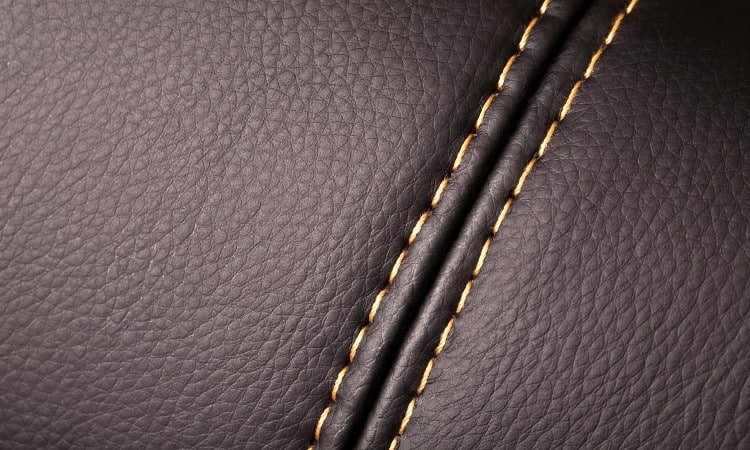
Quick Navigation
- How Do You Join Two Pieces of Leather Together?
- What Are Common Types of Leather Stitches? 6 Examples
- Functional vs. Decorative Leather Stitching
- What Is the Most Common Leather Stitching Technique?
- Which Stitches Are Strongest?
- What Types of Tools Are Needed For Leather Stitching?
- What Type of Thread Do You Use For Leather Stitches?
- Can Leather Be Stitched With a Regular Sewing Machine?
- Conclusion
How Do You Join Two Pieces of Leather Together?
Whichever of the many types of leather you use, most leathers can be joined together using leather stitches. The type of stitching you use will depend entirely on the look you are going for, how sturdy it needs to be, and how much time you want to spend making your stitches. Regardless of which you choose, leather stitching is an excellent way to securely join two pieces of leather together.
Leather is often very thick and is meant to be robust. To join two pieces of leather together with leather stitching, you’ll also need to consider the strength of the thread you are using. Go for a strong option like nylon to ensure your pieces stay firmly attached.
What Are Common Types of Leather Stitches? 6 Examples
There are many different types of leather stitching to choose from for leatherworking projects. Many experienced leatherworkers will create their own stitches to add artistic flare to their works. However, there are some common, fairly simple stitches that every leatherworker should know and use and you’ll see these stitches regularly in any leather goods you might buy.
1. Single Stitch
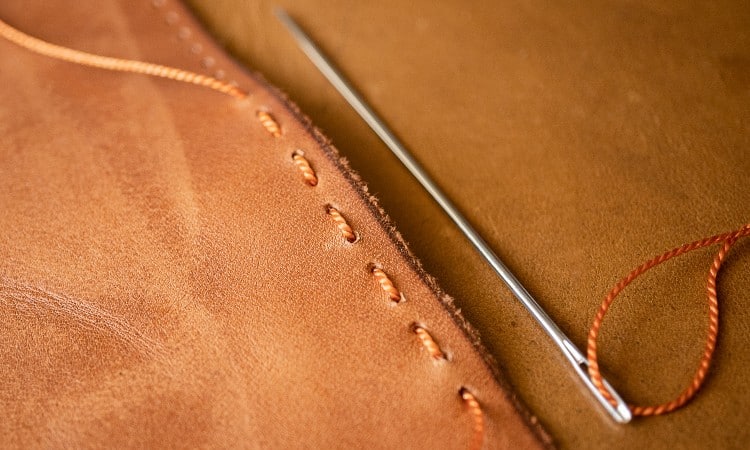
Single stitches are probably the simplest stitch you’ll see with leatherworking and one of the fastest. To do a single stitch, evenly spaced holes are placed along the edge of a piece of leather. A single strand of thread is passed through the eye of a needle and a knot is tied at the end of the strand to keep the thread from pulling through the hole.
Once the needle and thread are prepared, the needle is inserted into the second hole along the edge. The thread is then pulled through and the needle is inserted into the first hole punched in the leather. After that, the needle is inserted through the third hole before going back through the second.
It may be simpler to think of these stitches as a pattern. Start two holes forward, then move back one stitch. Move two holes forward, then go back one stitch. This stitch is completed all the way to the opposite edge of the leather.
The thread can be cut and tied at the other end. If it is a synthetic thread, it can also be burned into the leather to hold it in place.
2. Straight or Saddle Stitch
A straight stitch is also a fairly simple leather stitch but requires two needles instead of just one. It’s good for joining two pieces of leather together, specifically if they have equally spaced holes along their edges and are stacked on top of one another to align these holes.
For this type of stitch, a long piece of thread is cut and threaded through a needle at either of its ends. One needle is then inserted through both aligned holes at the starting point where the leather will be sewn. The thread is then pulled so that there is an equal amount of thread on either side of the piece.
Starting with the needle located on the left side of the piece, the thread is stitched through the second hole. At this stage, both needles are on the same side of the piece. The other needle is then threaded through the same hole as the first so that it is now on the opposite side from where it began.
The stitching continues to the end of the piece, with both needles continuing to be inserted into the same hole one after another. This creates a very sturdy binding between the two pieces of leather. Straight or saddle stitches are one of the strongest stitches available for leatherworking and can only be done by hand. It requires a lot of precision to be done well and is a great way to show off a craftsman’s skill.
3. Cross Stitch
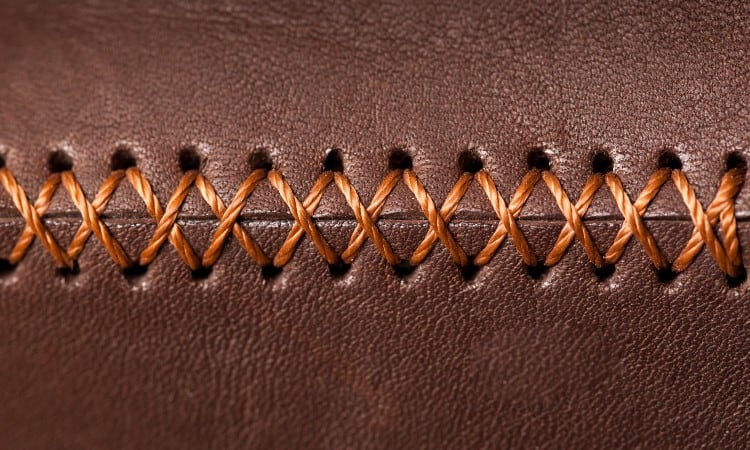
Cross stitches are very popular in leatherworking because they create a very attractive criss-cross or X pattern where two pieces of leather join. Each piece of leather has equally spaced holes along its outer edge. The thread is then woven back and forth in an X pattern, like how you would tie the laces of your tennis shoes or sneakers. Instead of a bow at the end, these stitches are tied off and burned in place if the thread is synthetic.
This type of stitch is one of the easiest leather stitches to learn, especially if you’re looking for a design that is a bit more decorative than what the single stitch or straight stitches offer. Even better, these stitches are very strong and durable and will last long wherever they are sewn.
4. Z-Stitch
The Z-stitch gets its name from the Z-like shape the threads form along the leather piece. These stitches start with a single piece of thread and a needle. The thread will need to be knotted at the opposite end so it doesn’t pass through the hole as you work.
Place the two pieces of leather that need to be joined alongside one another, with their holes aligned. Thread the needle through the first hole on one of the leather pieces, then cross it straight across to go through the first hole on the other piece.
Once that is finished, sew through the second hole on the opposite piece of leather. This will create a diagonal line that you will follow up with another straight line across the seam. This should create a “Z” shape joining the two pieces together.
You may need to wrap the thread around itself on the back of the piece and re-insert it through the hole it just passed through to keep the Z-design on the front of the work. It should always be facing outward so it is easy to see on the finished product!
5. Box Stitch
Box stitches are a popular choice if you want to attach two pieces together at a 90-degree angle. It’s often easiest to join these two pieces if you hold them at a 90-degree angle by securing them to the edge of a cardboard box or other surface. Make sure that your equally-spaced holes align along the two pieces of leather.
Then, take a threaded needle and pass it through each of the first holes a the top of the piece. It should go through the front of one hole before then going through the back of the other one. Move your needle down to the next hole, and repeat the process. You’ll continue this until you reach the end of the piece and can continue this with additional pieces of leather until you form a full box.
6. Baseball Stitch
If you’ve ever held a baseball in your hand and seen its decorative red stitching, you’ve seen American baseball stitching firsthand. This stitching style is known for its characteristic V-shape that runs along the seams where two pieces of leather are joined together. To create this stitching, both pieces of leather need to have equally-spaced holes along their edges where they will be sewn together.
Like some other types of stitches, baseball stitches require two needles to make. One needle needs to be threaded through the back of the end hole on each piece of leather, then pulled so that there is an equal amount of thread on both sides of the seam. This will give you two long pieces of thread on the front of your piece.
Take the needle on the right side, and pass it through the seam in between the two pieces of leather. Then, place it through the second hole on the left side, pushing it through from back to front. Repeat this process with the other needle, passing through the seam to emerge through the second hole on the right side of the project.
This should create the characteristic V-shape stitch that baseballs are known for. Continue with this stitch until you reach the end of the piece, being sure to pull your stitches tight enough that the two pieces of leather fully touch one another without a large gap.
Functional vs. Decorative Leather Stitching
When it comes to leather stitches, they can typically be one of two types – functional stitches or decorative stitches. Functional stitches serve a purpose, usually being added to hold two pieces of leather together. Without them, the piece would quickly fall apart.
Decorative leather stitching is added to make a piece look prettier than when it began. Some leatherworkers get creative with this, adding stitches meant to mimic braids, flowers, leaves, and other artistic designs. These aren’t required to keep the piece together but give it a bit of added flair.
Many leather workers will turn to traditional embroidery styles as inspiration for their decorative stitching. There’s no limit to what can be done with these types of embellishments since they don’t have to serve any kind of a functional purpose.
The common stitches described in this article can all be used as functional stitching to hold two pieces of leather together. However, some of them can be considered somewhat decorative since they add a little bit of extra beauty to the final leather piece once finished. This includes the cross stitch, the Z-stitch, and the baseball stitch.
What Is the Most Common Leather Stitching Technique?
The most common leather stitching technique is usually the straight stitch or saddle stitch since it is fairly simple but incredibly strong for joining pieces of leather together. It also looks attractive and neat when done well and can be used to add a pop of color if you choose a contrasting color of thread to work with. All-in-all, it’s a good option for pretty much any project.
Which Stitches Are Strongest?
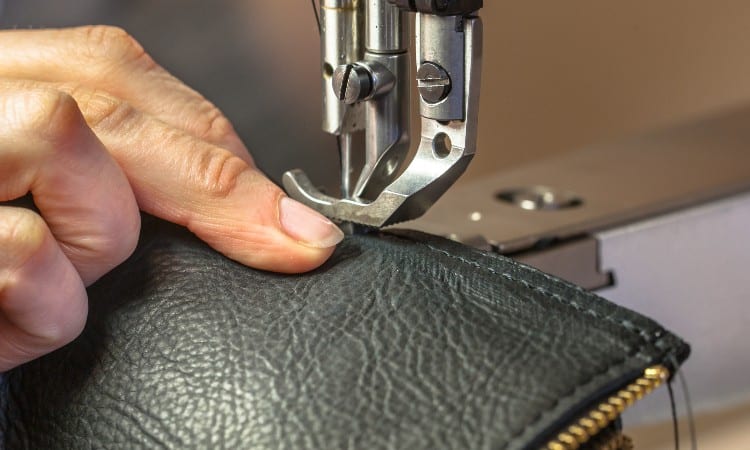
The stitches that are the strongest tend to be the ones that have multiple threads passing through the same hole. These types of stitches tend to be double stitches, giving them twice as much strength as a single stitch would have. A straight or saddle stitch is an excellent example since two pieces of thread pass through each hole where the leather is joined.
While not quite strong as a straight or saddle stitch, baseball and cross stitches join together with two strands of thread instead of one. These stitches also have the added benefit of being a bit more decorative, making them useful for areas of a leather piece that will be very visible when used or worn.
What Types of Tools Are Needed For Leather Stitching?
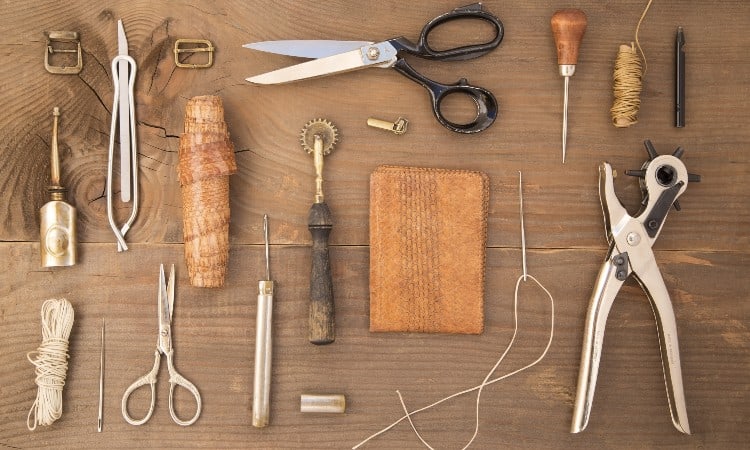
Many different tools are used to hand stitch leather. At the very least, you will need needles capable of sewing through the leather. This typically means you will need at least two longer, thicker sewing needles that aren’t quite as sharp but will hold their own against the stiff fabric.
You’ll also need something to make holes along the edges of your leather. An awl works best for this, but some people succeed with other types of borers that can make even holes in the leather. A knife or other sharp blade can work in a pinch but isn’t the best for creating neat, rounded holes.
Beyond that, you’ll need sturdy thread and maybe something to hold the leather in place as you work. Many leatherworkers will buy specialized clamps or even a stitching pony to hold the leather in place so your hands will be free as you work. These types of products are great for holding the leather and making the process easier overall but aren’t necessarily required.
What Type of Thread Do You Use For Leather Stitches?
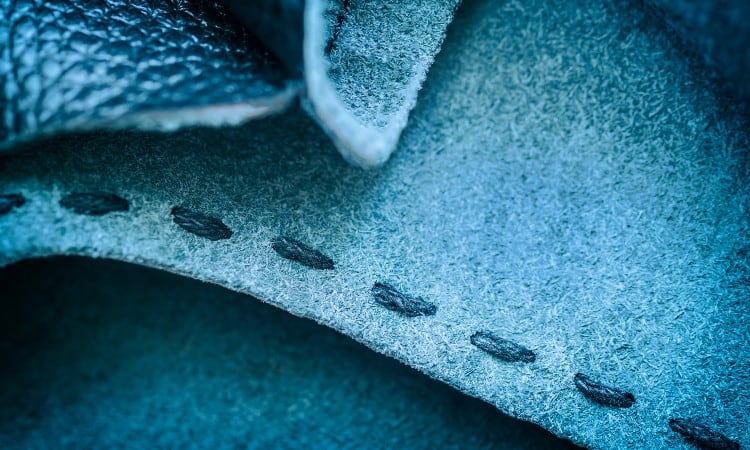
There are many different options you can use to stitch leather. On the whole, you need a sturdy thread to hold up to the thick leather. Too thin of thread will break over time due to the friction of the leather pieces moving.
Nylon thread is usually the best option, especially if it is waxed. The wax layer on the thread acts as a protective barrier to keep it from fraying over time. It will also help stop the thread from breaking down as you use it and will let it pass smoothly through the rough holes you’ve made in the leather.
Bonded nylon thread, in particular, is recommended for leatherworking. The bonding process makes it stronger and further helps to reduce friction as you sew. It even comes in different weights and thicknesses, meaning that you can get very sturdy thread for any type of leather project you might be working on.
Can Leather Be Stitched With a Regular Sewing Machine?
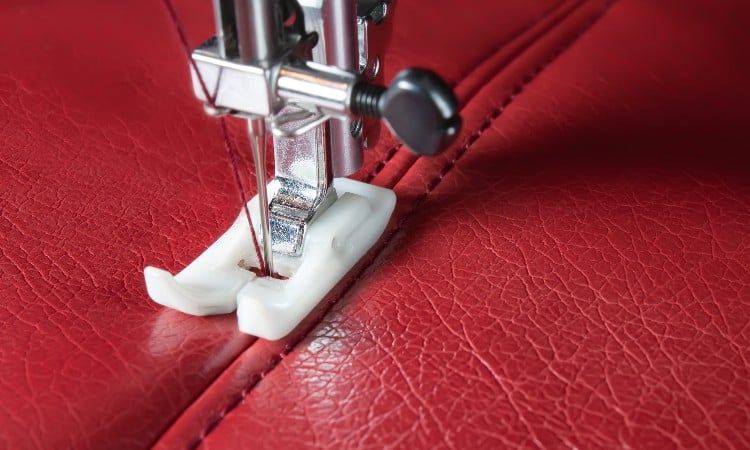
Yes, leather can be stitched with a regular sewing machine if you take certain steps. For starters, you will want to change the presser foot on your machine to one that works well with leather – such as a roller foot or a Teflon foot. Ordinary presser feet will stick to the leather, while both options will move smoothly over the surface of it.
Then, you’ll need to change your needles to something strong enough to push through the leather. Specifically, look for heavy-duty leather needles and have a special tip for these types of projects. You might need to order these online and get more than one – leather is very tough and you’re likely to break a few needles along the way.
The right thread is also going to be important. Cotton and other thin threads are a no-go when it comes to leather. Stick to nylon or other synthetics instead, and try to choose one that is heavy-duty and meant for top stitching. It will hold up better over time and give a nicer finished look.
You can space out your stitches with leather since they don’t need to be as close together. Try going for a longer stitch length – between a 3.0 and a 4.0 to reduce the number of holes the machine makes in the leather as you sew. Also, remember that any holes you make cannot be disguised or filled back in, so try to place your stitches exactly where you want them.
Conclusion
Leather stitching is a great way to join together two pieces of leather securely and beautifully. This article has introduced you to the most common types of leather stitches you will likely see in the leather goods you own. Keep this list handy if you decide to try these stitches out for yourself!